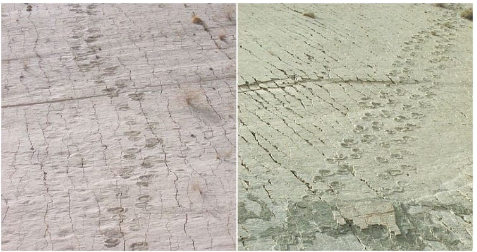
In Cal Orko, Bolivia, there is a limestone wall that is 300 feet long and has over 10,000 dinosaur footprints etched on it. The footprints date back around 68 million years, and they come from ten distinct dinosaur species that once roamed the planet. In Bolivia’s Cal Orko, there is a wall that is 1.2 kilometers long and 80 meters high. A slab of limestone that was formerly part of the dinosaur era makes up the wall.
It is covered in a multitude of dinosaur tracks that, according to specialists, come from about 10 different dinosaur species. As of right now, the limestone wall has over 10,000 distinct dinosaur footprints detected.
Only about 3,000 dinosaur tracks could be found in 1998, according to Swiss palaeontologist Christian Meyer. The amount of footprints increased to 5,000 in 2007 and, according to the most recent survey, over 10,000 distinct dinosaur footprints were found in the limestone slab.
The quadrupedal titanosaur tracks are the most noticeable ones on the limestone wall. Throughout the whole wall are the footprints of the predatory, bipedal dinosaurs.
Additional dinosaur species whose footprints were discovered on the wall are theropods, ornithopods, quadrupedal ornithopods, and ankylosaurs.
It appears from the wall that the dinosaurs walked vertically. However, the wall’s initial surface was really the Cretaceous bottom of a shallow lake. The floor went vertical because to tectonic movements.
The nearly vertical limestone slab creates the illusion that the dinosaurs were moving vertically, much like lizards on a wall. However, specialists have offered a more sensible reason. The limestone slab was once the bottom of a shallow lake that meandered over South America during the Cretaceous era.
Geologists claim that tectonic plate movement has caused the lake’s floor to shift many times. Hundreds of dinosaurs walked over the floor 68 million years ago, leaving their imprints in the process.
Paleontological remains are remarkably abundant in Cal Orko, Bolivia, which is thought to be caused by the region’s distinct climate changes.
Why are dinosaur remains found in this area in such large numbers? Experts surmise that it may be related to the region’s particular climatic variations. The massive hooves of the dinosaurs sank into the soft lakebed that had stood there.
The tracks hardened when the region experienced drought. The tracks were hidden behind mud and silt layers when the rainy weather returned. Experts surmise that the prints on the lake floor were retained because of the repetition of this wet-dry pattern up to seven times.
The best part was that the species that survived the dinosaur era on this planet could now witness this amazing paleontological display because tectonic activity had moved the floor into a vertical viewing position.
In addition to a guided one-hour tour of a few chosen portions of the dinosaur footprint wall, the Cal Orko Parque Cretacico features a museum, models of dinosaurs, fossils, and related paleontological material.
In order to see the dinosaur footprints, tourists can now take guided excursions. Because of the cement factory next to the wall, visitors must wear helmets as a matter of safety.
The guides point out the imprints left by the long-necked herbivorous Sauropods and the predatory Theropod dinosaurs. The footprint trackways are anywhere from 26 feet to an incredible 65 feet long.
This amazing slab of limestone records and provides an insight into the dynamic history of the Cretaceous period.
